4LIYC Officers & History
Who We Are
We’ve been building and racing iceboats for over 100 years in Madison, Wisconsin, USA.
Four Lakes Ice Yacht Club Officers for the 2023-2024 Season
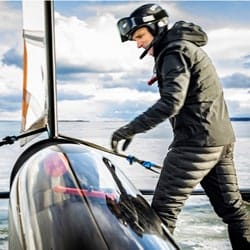
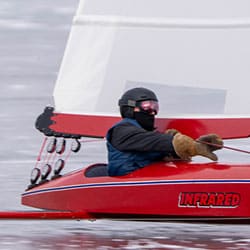
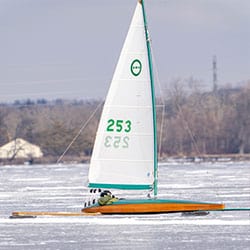
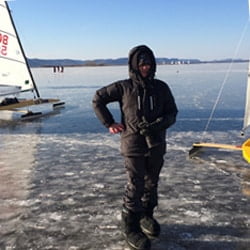
Commodore Daniel Hearn
dhearnUS5352@gmail.com
608-692-4007
Vice Commodore Ron Rosten
ron.rosten@gmail.com
608-692-8816
Treasurer Rhonda Arries
treasurer.4liyc@gmail.com
Secretary & Webmaster
Deb Whitehorse
608-347-3513
debwhitehorse@iceboat.org
A Brief History of Ice Yachting in Madison, WI
By Debra Whitehorse,
Secretary & Webmaster, 4LIYC
Madison, Wisconsin has been regarded a hotbed of ice yachting since the 1800’s. Set atop an isthmus, Madison is bracketed by Lakes Mendota and Monona. A few miles south Lake Waubesa and Lake Kegonsa complete the foursome.
Our four lakes have seen a myriad of ice boat designs throughout the years, from rustic, home-made boats, to high-tech carbon fiber creations worthy of an art museum. In 1878, Harper’s Bazaar Magazine recognized Madison’s prominence in the sport in an article with a now famous engraving that depicts ice yachts and the scenic isthmus.
ICE BOATING: The City of Madison, Wisconsin is built upon an undulating
isthmus between Mendota and Monona, two of a chain of four beautiful lakes.
Like the Dutch, resourceful Madisonians took advantage of the frozen lakes to convey men and construction materials from outlying areas to the city by the means of iceboats. Carl Bernard, a famous Madison ice boater, recalled in an interview that his father William transported stone from Governor’s Island and Maple Bluff for the rebuilding of the state capitol in the early part of the twentieth century. Similar to an old fashioned mortar box, the boats were constructed of three cornered platforms set upon plow-share steel runners. Two of the runners were bolted to the wood, the back third corner held the steering rudder.
Detail from oil painting by Dutch artist Hendrick Avercamp, c.1608.
The traditional Dutch style iceboat is in the upper right with the flag flying off the mast.
In the late 1800’s, commissioning the construction of ice boats became a fashionable pastime for wealthy easterners like the Roosevelt family. Their crafts came to be known as the Hudson River Style and were usually piloted by paid skippers. In the early 1920s, ice breakers clearing the river for commercial shipping made conditions difficult for ice boaters. Today the New York Hudson River stern-steerers are making a come back thanks to the efforts of their dedicated sailors.
A Class of Boat Named for a City
The Madison Style Boat
Another style of boat developed that came to be called the Madison Style. These were a smaller versions of the Hudson River style with a triangular box for it’s body, a gaff-rigged cornered 350 square foot sail with jib, and the tiller aft. Ice boaters in Oshkosh, Wisconsin; Lake Geneva, Wisconsin; Menominee, Michigan; Toledo, Ohio; and Gull Lake, Michigan also developed their own style of stern steerer.
In 1874 German immigrant Charles Bernard Sr., who’d been building ice boats in Madison since the 1850s, established a boat works in the 600 block of East Gorham on Lake Mendota. By the 1930’s their business and the popularity of iceboating had grown to the point that they kept a fleet of ice boats available for rental. Charles’ son William Bernard developed the Madison style stern steerer. William built many championship ice yachts including the famous Princess boats for Emil Fauerbach, winner of the Hearst and Stuart International Trophies. William’s son Carl carried on the family tradition of ice yachting. In addition to building boats, he skippered two renowned Madison stern steerers of the Hudson River style, the Fritz and the Mary B through the 1950s.
The last Madison Style stern steerer constructed was Miss Madison in 1927. She can still be seen on Lake Monona skipped by Richard Litchfeld, who has kept her in period condition. Legendary Madison skipper, Jack Ripp, remembers,”….those Madison Styles were the worst! Big, long bow sprit out front, you know, and a short back end, just asking for a spin.” Jack recalls that the first boat he ever bought, a Madison Style for fifteen dollars “every time you hiked, you could bet fifty dollars on it, soon as that runner came down on the ice, you were going to spin. I don’t care what you did, around you go….. Out you went! But it was fun.”
William Bernard is the grandfather of iceboating in Madison. Iceboat racing here all began with him.
Serious coverage of ice boating hasn’t been seen on local sports pages since the 1960’s. However, the most important aspects of the sport, including technical development, the search for speed, inter and in club rivalry, sportsmanship, and competition remain the same. One wonders if those skippers of the 19th Century hundred year ever imagined that their ice boat club would still be in existence at the dawn of the 21st Century.
In 1913, Madison ice boaters joined representatives of the other major ice yacht clubs and formed the Northwest Ice Yacht Association for the purpose of sanctioning an annual regatta. The Northwest Regatta remains an important ice boat regatta to this day. In 1914,Emil Fauerbach became the first Madison ice boater to win the A stern steerer Northwest title. During the next 90 years, other Madison skippers have taken home honors of the Northwest. In 2004, Bob Kau joined that elite list by winning the Skeeter Class competition.
The Four Lakes Ice Yacht Club was incorporated on January 13, 1921 “to promote and sanction the sport of ice yacht racing”. Prior to 1921, Madison ice boaters were a somewhat divided group and there was a lively rivalry between Lake Monona and Lake Mendota skippers.
After years of trying, Emil Fauerbach and his Princess II, won the most prestigious ice yacht trophy of the day. In 1914, he won the Hearst International Trophy deeded by the newspaper magnate, William Randolph Hearst. Carl Bernard also gained national prominence as a Madison ice boater. In 1934 he won three major regattas at the helm of the Fritz, a Hudson River-style boat owned by Fritz Jungbluth and built by Frank Teztlaff. Bernard aced the Hearst, Stuart, the Northwestern A Class championship, and the Northwest Free For All. The Fritz won the Class A NIYA championship another four times.
Fritz Jungbluth & Frank Tetzlaff on the Fritz, c. 1934
One of the most famous stern-steerers in Madison, the Mary B.
At the tiller, Carl Bernard, OT Havey, her owner,
and the namesake of the boat herself, Mary B. Havey.
In the 1920s and 30s,about one hundred boats would participate in Four Lakes Ice Yacht Club’s races. Oddly enough, Madison’s electric and gas power plant had much to do with the consistently excellent sailing conditions on Lake Monona. When other area lakes would have too much snow for ice boating, the soot from coal burned at the power plant coupled with the prevailing winds kept Lake Monona’s ice snow-free. The only drawback was, as Jack Ripp recalled, that the coal cinders were “hell on runners”. A skipper had to sharpen runners more often when sailing on Lake Monona.
According to Ripp, the majority of the boats were home-made stern steerers and there were only about four or five front steerers. In the coming years, the front steerers would come to dominate.
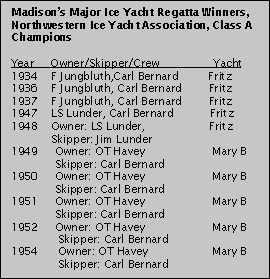
Dawn of the Skeeters
Madison’s Winning Tradition Evolves
The “Big Boats” ruled Madison’s frozen lakes up until the late 1940’s when the Skeeter Class began to rule. The Skeeter, so named because its’ 75 square foot sail looked like a mosquito compared to the sails of a Madison Style Big Boat, has its roots in a boat developed by Milwaukee’s Starke Meyer in 1930.
Unlike a stern steerer, the Skeeter steering runner is at the forward end of the hull, the enclosed hull is long and narrow, the sail is triangular shaped. The cockpit is over the runner plank. Sitka spruce was the wood of choice for a Skeeter’s fuselage, runner plank, and mast.
Skeeters had many advantages over the old stern steerers and Madison ice yachters enthusiastically took up the class. Skeeters could be inexpensively (at least in those days!) built in ones’ basement or garage. Skeeters were easily transported to the ice via a trailer or car rooftop. The set-up/tear-down process was a breeze compared to the hours and man power needed to properly set up a stern steerer. Probably the biggest attraction that the Skeeter had to a budding sailor was the fact that it was a one-skipper boat whereas the big boats were staffed with a skipper and at least two or three crewmen.
Another draw that the Skeeter class still has today is that it has few design specifications other than a seventy five square foot sail area. Skeeters are the speed demons of the ice boat world, capable of reaching speeds well over one hundred miles an hour. In the 1950’s a group of young Madison men, many of them still teenagers, began designing and building E Skeeters. The Four Lakes Ice Yacht Club’s most legendary Skeeter class designers, builders, and pilots Jack Ripp, Bill Mattison, Paul Krueger, and Dave Rosten would go on to win dozens of championships in the highly competitive world of the “Formula One” of ice boating.
© Debra Rosten Whitehorse
Part II: Home of the Champions 4LIYC Skippers Bring Home the Hardware
By Greg Whitehorse
In 1955 Madison’s Jack Ripp, a member of the 4LIYC since the mid-forties, put his accumulated knowledge of iceboat design and construction into a brand new Class E Skeeter, Miss Fortune III. The beautifully constructed, red with white trim craft, was not a radical departure from the fast Skeeters of its day, rather it was the natural evolution of the design.
Jack Ripp in Miss Fortune III on Lake Monona.
As mentioned, the new boat proved to be fast and Jack Ripp was able to capture the 1957 Northwestern Regatta Skeeter class championship, which was sailed that year on Lake Monona. Ripp, now a many-time Renegade class champion, began the Four Lakes Ice Yacht Club Skeeter class winning tradition when he won his first Northwest Ice Yacht Association Class E Skeeter title in 1957. Jack went on to bring home the NIYA Skeeter class first-place trophy four more times, and collected another four first-place finishes in the NIYA Renegade class. To top it off, this talented iceboat designer, builder, and sailors’ championship pedigree includes an International Skeeter championship, three Ice Yacht Challenge Pennant of America victories, and numerous club championships.Forty five years later,an active Renegade skipper, Jack remains an odds on favorite in any regatta.
Others in the 4LIYC area saw the success that Ripp was beginning to enjoy with his new boat and soon sitka spruce shavings were piling up on the floors of many area basements and garages in a boat building frenzy.
In 1962, long time 4LIYC member, Bill Mattison, won the first of his many ISA (International Skeeter Association) World Championships in the Skeeter class sailing his red and white beauty, Honeybucket V. Mattison would go on to win nearly twenty major ice yacht regattas and Triple Crowns in various incarnations of Honeybucket.
4LIYC Skippers Sweep to Regatta Victories
By the mid-sixties the 4LIYC had firmly established itself as “The Home of the Champions”. Joining Jack Ripp and Bill Mattison on the cutting edge of Skeeter design and racing were club members Dave Rosten and Paul Krueger. Like true champions these leading designers and builders shared the knowledge they gained with others that were looking to join the club’s Skeeter fleet. Regattas with nearly fifty Class E Skeeters entered were the norm through-out the sixties, and a large number of those boats were built by Bill Mattison, Dave Rosten, Paul Krueger, and Jack Ripp.
Paul Krueger, Bill Mattison, and Dave Rosten in 1969.
During the late sixties and into the early seventies, new Class E Skeeters were being built with near production line efficiency in the basements and garages of Mattison, Krueger, and Rosten. Although a few of these well turned out boats were going to skippers outside the 4LIYC area, most were custom built for new owners within our club. It was not unusual for up to sixteen fast competitive Skeeters, with ‘M’s on their sails, to line up for our club races. The local competition was fierce as our club races had an almost regatta like feel to them. This, of course, helped 4LIYC skippers gain a noticeable edge when competing in national regattas. Soon other club members were chasing down regatta glories.
In 1967 Jack Ripp switched from the wide-open Skeeter fleet to the one-design Renegade class. It was an unusual move in light of the fact that he was at the pinnacle of the Skeeter fleet at that time, and that there were virtually no active Renegades in the Four Lakes area. But Ripp saw the writing on the wall early. The no holds barred Skeeters were becoming increasingly expensive if one wished to remain competitive. Changes needed to be made every year in order to stay on top.
Jack Ripp in his Renegade Jack Frost III c.2000.
Over the years the talented skippers of the 4LIYC would post regatta titles in many different classes of iceboats. But interestingly, no club member would ever notch a DN class regatta championship. Despite the fact that the DN has been raced in our club since the fifties. In the late sixties and early seventies a few club members would come close. Jack Loew, Ed Elaranta, and Bob Gilson all ran well in several regattas, but they couldn’t quite bring home the regatta title. It seemed that in the 4LIYC, sailing and racing a DN was almost always the means to an end for most of those skippers. A few years behind the tiller of a DN, and then switch to another class of boat was a continuum to the norm. In the seventies most of the active 4LIYC Skeeter, Renegade, and Nite pilots could look back on their beginnings in the DN fleet.
The Early 1970’s
Skeeters and Renegades Outnumber Traditional Big Boats
In 1973 the club lost one of its most celebrated members. Dave Rosten, died at the age of 36. Rosten’s record included three ISA World Skeeter championships and two Northwestern Skeeter titles. He had also been a member of four successful Ice Yacht Challenge Pennant of America teams, when he tragically lost his life in a snowmobile accident. Given that ice yachting is a sport that rewards experience over youth, surely many more regatta championships would have come his way.
By the early seventies with the popularity of the Skeeter, the increased interest in the Renegade class, and the introduction of the Nite iceboat, came the eventual decline of the ‘Big Boats’. The large, Marconi rigged stern-steerers, which at one time numbered in the hundreds on the Madison area lakes, were now down to just three competitive Class C boats. Continuing to campaign the traditional stern-steerers were 1961 Northwestern C Boat Champ, Dave Butler, sailing the Ace of Spades, Mike McCormick piloting Pieces of Eight, and seven time (1966, 1967, 1969, 1973-1976) Northwestern Champion, Bill McCormick sailing Twin Beds. When Butler retired from the sport in the early seventies, it left only the McCormick brothers to carry on the century old tradition of racing stern-steering ice yachts in the Four Lakes area.
Twin Beds, the World’s Fastest C Stern Steerer.
The Appearance of the Rear Seater Skeeter
Krueger and Mattison in the Vanguard
In 1975, Madison skipper Paul Krueger was involved in a serious iceboating accident while competing in a Northwestern Regatta on Lake Winnebago. Krueger thought that part of the cause of the accident was the limited vision one had while sitting under the boom when sailing a Skeeter. With that in mind he designed and built the first rear-seater Skeeter for the 1976 sailing season.
Not only did the skipper not have to duck under the boom on each jibe or tack; he also enjoyed a much larger field of vision. The new design also allowed the gap between the boom and deck to be closed. In other words, when fully trimmed, the boom was now pulled down to meet the deck This greatly enhanced the performance of the already potent Class E Skeeter iceboat.
Paul Krueger’s A Class Skeeters spanning 40+ years: From left, Ramblin’ c. 1970, Ramblin’ c.1980, Ramblin’ 2015 ISA
Outside the 4LIYC area some Skeeter sailors were not real happy about having to make yet another change in their yachts, even though no parts off the old boats were made obsolete with Krueger’s new design. The hull was fairly easily converted to rear seat dimensions, and the existing boom only needed to be made a little wider.
Soon all serious contenders in the Skeeter fleet were sailing rear seaters. In 1977 Ken Whitehorse sailed a Krueger reconfigured Skeeter to a Northwestern Championship, becoming yet another 4LIYC member to win a major regatta.
Throughout the sixties and seventies, Bill Mattison continued to win regatta after regatta . A succession of Skeeter iceboats named ‘Honeybucket’, each one faster than the previous, brought Mattison ISA World Championships in 1962,1963, 1966, 1968, 1969, 1971, 1973, and 1977, along with a Northwestern Regatta win in 1969. He was also a member of five successful Ice Yacht Challenge Pennant of America teams during this period.
Bill Mattison in his element, the iceboat shop on Williamson Street in Madison, WI.
This was likely Bill’s last Honeybucket, still in primer, on Lake Mendota from February 28, 2004.
Meanwhile, the 4LIYC Renegade fleet was starting to enjoy a renaissance during the sixties and seventies. In 1976, at a ISA/IRIYA (International Renegade Ice Yacht Association) Regatta on Lake Mendota , Jerry Simon and his yacht Simonized II captured the first championship for a 4LIYC Renegade skipper. It looked as though Simon’s victory was what the club needed to establish itself as power in Renegade racing.
Jerry Simon sailing his Renegade on Lake Monona in 2014.
By the mid-eighties Skeeter competition from around the country was as tight as ever. The Ice Yacht Challenge Pennant of America, a trophy originally put up by the Roosevelt Family, of Hyde Park New York, was in the possession of the Skeeter Ice Boat Club, of Williams Bay Wisconsin. The 4LIYC had last been in possession of it in 1970, when it was lost to the challenging yachts from the Pewaukee Ice Yacht Club. In 1986 the Skeeter Ice Boat Club again put the coveted pennant up for challenge. In a stunning upset, Four Lake’s A.J. Whitehorse, sailing his sleek, needle-nosed Skeeter, Eagle I, dominated the competition to bring the Pennant back to Madison. Bill Mattison was teamed with A.J. that year, it was Mattison’s sixth successful Challenge Pennant effort. (For the full story on the 1986 Ice Yacht Challenge Pennant go to the Fall 1999 Blade Runner.)
In 1987 Jack Ripp would finally end a twenty year drought in regatta competition, (although he had been very close to winning on several occasions during that span), when he captured the IRIYA Renegade Championship. Ripp would go on to post Northwestern titles in 1988,1989,1992, and 1998. He would add on to his IRIYA regatta totals with victories in 1988,1991, and 1996. By the mid nineties the, 4LIYC Renegade fleet would number in the twenties with many club boats becoming contenders at the national regattas.
Tim McCormick getting ready to race.
In 1988, the 4LIYC added yet another name to its already impressive list of Class E Skeeter ISA world champions, Ken Kreider. Sailing his shocking pink yacht, POON, Kreider sailed to victory at a regatta held on Lake Mendota. Six years later, in 1994, at a Northwestern Regatta held on Lake Winnebago at Oshkosh, Kreider again emerged victorious after a exciting three days of racing in high winds and on very rough ice.
Ken Kreider
When the 1992 DN North American Championships were held on Madison’s Lake Mendota, 4LIYC DNer Mike Fullerton won the Bronze Fleet Championship. It finally looked as though the club was going to turn the coiner in DN competition. Madison DN skippers were building new spars and runners, new high-tech sails were being ordered every year, the club’s DN fleet was beginning to look as modem as anyone’s. But when some of these skippers moved from the Madison area, and others followed the old tradition of using the DN as a stepping stone to other classes, the club DN fleet was again suffering.
Entering the New Millennium
The Four Lakes Ice Yacht Club enters the new millennium as the premier ice yacht club in the country. Our club members are, as always, a force to be reckoned with at the national regattas in nearly any class of iceboat. Locally, we conduct out club races in a professional manner, always with properly set marks, starting blocks, a Chief Judge, and a scorer. We continue to ran races for four different classes of ice yachts, Skeeters, Renegades, Nites, and DN’s, during our club racing schedule.
Our on-ice equipment includes a four wheel, All Terrain Vehicle (ATV), set up with an accurate anemometer, digital thermometer, and wind vane. It is also outfitted with a VHF radio communications system. On the ice safety equipment includes an evacuation sled, medical supplies and thermo blankets, along with rope and fife buoys. We carry all this equipment to our club races and local regattas in a new trailer which can also serve as a scoring booth.
The Jim Payton Safety Vehicle parked at Springer’s on Lake Kegonsa. Springer’s has been very accomodating to our club.
The 4LIYC holds meetings every other week from about mid-November until late March. These meetings include an election of officers at the second meeting of the year and a business meeting in February. All 4LIYC meetings are open to the public, and anyone with an interest in iceboating is welcome to join. The 4LIYC can boast of its largest membership in its long history during the 1999-2000 season.
Every spring the club holds its annual awards banquet, where more than thirty perpetual trophies are awarded to our club champions, top season finishers, and special race winners. Many of these beautiful trophies have a rich history, dating back to the late 1940’s.
The history of the Four Lakes Ice Yacht Club is an ongoing story. Be sure to check back here for the latest updates. Better yet, become an active 4LIYC skipper and become part of it.
© Greg Whitehorse
